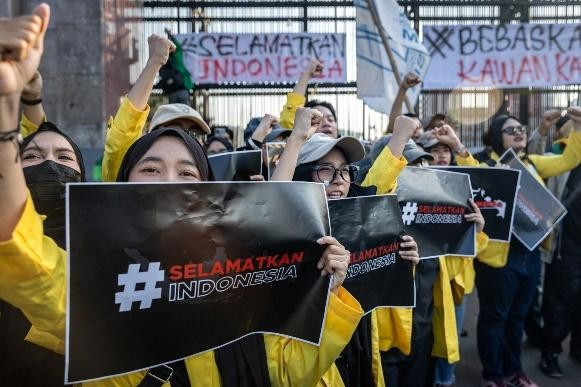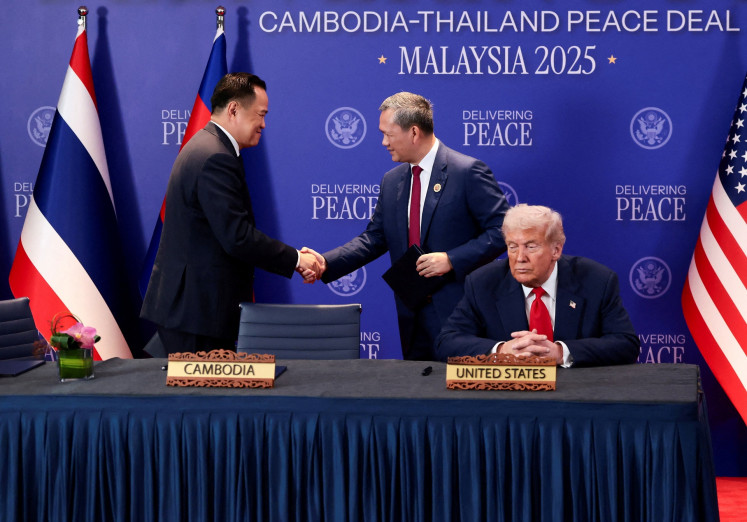Popular Reads
Top Results
Can't find what you're looking for?
View all search resultsPopular Reads
Top Results
Can't find what you're looking for?
View all search resultsSurabaya’s antidote to rise of concrete jungles
Change text size
Gift Premium Articles
to Anyone
T
he East Java capital of Surabaya made public parks where others erected buildings. It is now reaping the creative, economic and cooling benefits.
Surabaya, Indonesia’s second-largest city, is known for its oppressive heat. It is a reputation the city’s first female mayor, Tri Rismaharini, set out to change more than a decade ago.
Other cities, also beset by the urban heat island effect, are now looking to Surabaya as the climate warms.
As green spaces are replaced with concrete jungles, the urban heat island effect pushes temperatures higher – by up to 5.3 degrees Celsius. This adversely affects sleep quality and appetite, and has been associated with depression, diabetes, heart disease and dementia.
Urban heat stress also influences productivity and drives up heat-related illnesses and death.
Indonesia is a growing nation where 57 percent of the population lives in urban areas. The urban population is increasing by 2.2 percent a year, adding to heat stress. Indonesia has not been keeping records on deaths due to heat hazards, but new evidence points to very strong heat stress in Indonesia’s city centers.
Urban residents around the world are increasingly forced to reduce physical activity, stay in a shaded place, or spend most of their time indoors in an air-conditioned environment. Awareness campaigns on the risks of heat stress have not yet been implemented in Indonesia.
In the future, without local government intervention, already hot areas are expected to get hotter and expand into the neighboring regions. The cities of Medan and Denpasar will shortly experience a heat stress index increase of 3.1 degrees. In contrast, in Surabaya, the heat stress index will be reduced by 0.8 degrees in the near future.
The difference is the result of increased vegetation coverage in Surabaya. In the past decade, Surabaya has built urban parks with a focus on public creative spaces. These have also brought economic benefits. One, Bungkul Park, serves multiple purposes, including supporting street vendors, sports and recreation and art activities.
Surabaya’s Green and Clean (SGC) program transformed the village of Margorukun, previously a slum area with a high crime rate. Today, locals grow ornamental plants and produce handicrafts with recycled garbage, with the proceeds providing an income or going toward ecotourism sustainability.
Given climate change, urban greening is a low-regret intervention that provides significant benefits at a low cost. Air purification, flood control, recreational space, CO2 sequestration and food production are just a few of the services urban vegetation can provide.
Indonesian law mandates that at least 30 percent of urban areas be dedicated to open green spaces. This law also applies to spatial planning in the provinces and districts (RTRW). But not every local government is on board, some preferring to prioritize economic growth and job creation.
Surabaya has tried to achieve both – setting a target for open green spaces in its master plan with 20 percent public space and 10 percent private space. With a public open green space ratio of 20.75 percent in 2015, this policy was consistent with national regulation, and efficiently implemented and enforced.
Even though this urban green space is not explicitly intended to reduce urban heat island pressure, this one action with multiple benefits can reduce the heat stress in Surabaya, offering inspiration for other cities in Indonesia and around the world.
—
The writer is a researcher in the Research Center for Oceanography at the National Research and Innovation Agency (BRIN).











